General election 2019: preview of Yorkshire and the Humber
In the run-up to the 2019 general election, the Democratic Audit team are previewing the key contests, and political divides in each of the country’s regions. On some forecasts Yorkshire and the Humber will see the most political upheaval, with the Conservatives campaigning hard to gain the advantage in areas long considered to be Labour strongholds. We focus on the key seats based on 2017’s marginal results, the latest polling, and how the Leave-Remain dynamic changes the established electoral contests.
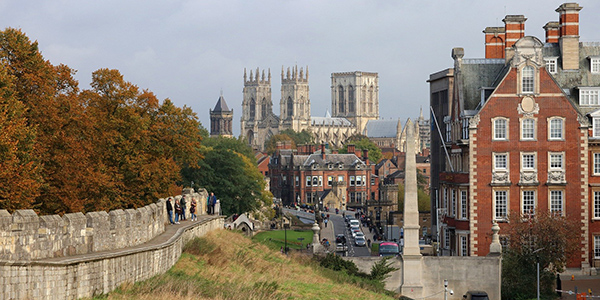
York. Picture: Emphyrio from Pixabay
In 2017, the Conservatives failed to gain any ground in Yorkshire and the Humber in their campaign to take ‘Labour Leave’ seats, with the Labour Party instead benefiting at the expense of both the Conservatives and the Lib Dems. They took Colne Valley and Keighley from the Tories and Leeds North West and Sheffield Hallam from the Lib Dems, increasing the Labour seat count to 37. The Conservatives currently have 17 seats here, with particularly safe seats for them in rural North Yorkshire, and they also hold more marginal seats in West Yorkshire, including seats like Morley and Outwood, where they ousted former Labour Shadow Chancellor Ed Balls in 2015. The Lib Dems currently have no seats in the region.
This time around, numerous constituencies in South and West Yorkshire along with Humberside form part of what has been dubbed ‘the red wall’ of Labour seats that voted Leave. Along with the West Midlands, it offers the Conservatives the most possibilities for seat gains and has been a focus for Johnson’s campaign, with several campaign visits to constituencies such as Great Grimsby. On the latest polling, the Conservatives will pick up a substantial number of seats here, and could even draw level with Labour on vote share and close the gap on seat share (see figures 1 and 2). This is in-keeping with the national narrative, but as ever local dynamics matter too, best exemplified by the presence of the Yorkshire Party, which was founded in 2014 and is fielding candidates in 28 seats. They advocate Yorkshire-wide devolution. Other contests are further complicated by strong polling numbers for the Brexit Party, who came first here in the European Parliament elections, and have some of their top constituency targets here, while the Lib Dems have one winnable target in the region: reclaiming Sheffield Hallam.
Map of Yorkshire and Humber 2017 general election results, with key seats labelled
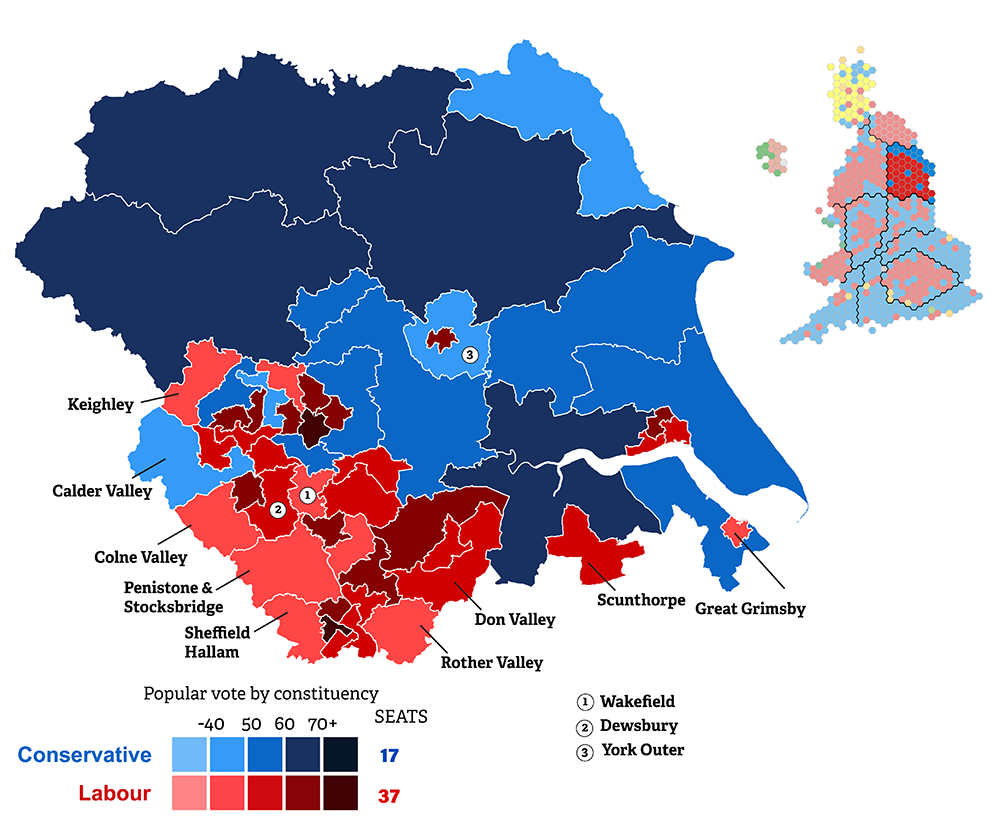
Source: Adapted from map by DrRandomFactor & Ch1902 /Wikipedia. Key constituency contests for 2019 labelled.
For all seats in the region, you can find full details of the candidates standing in 2019 and their social media links at DemocraticDashboard.com. It also gives complete results from the 2017 general election, estimated 2016 EU referendum results and details about the constituency so you can best make up your own mind how to vote.
The estimated constituency results for all seats in Yorkshire and Humber in 2019, and regional vote shares given in figures 1 and 2, come from YouGov’s large MRP poll published on 10 December, which are the best available data at the time of writing. A sample of 105,612 people was polled across the UK, and used, along with demographic and other data, to create estimates for each constituency.
Figure 1: Number of seats won by each party at the last three general elections in Yorkshire and Humber, and 2019 estimates from YouGov polling, 10 December
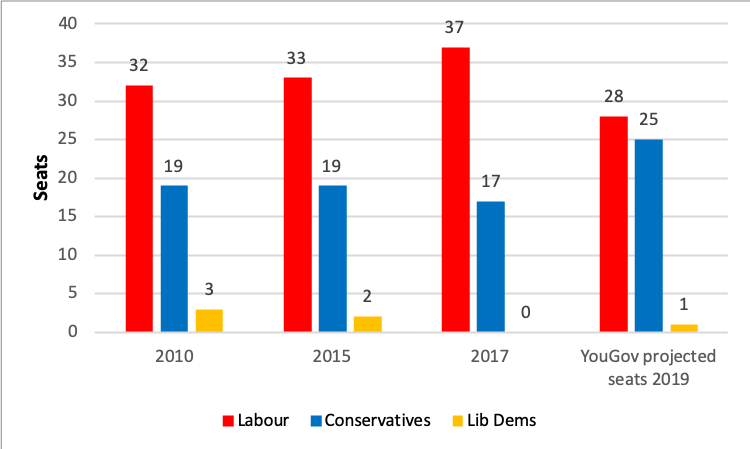
Note: 2019 figures from YouGov MRP seat estimates, 10 December, 2019.
Figure 2: Parties’ shares of the votes in Yorkshire and Humber at the last three general elections, and estimated vote shares from YouGov’s 10 December poll
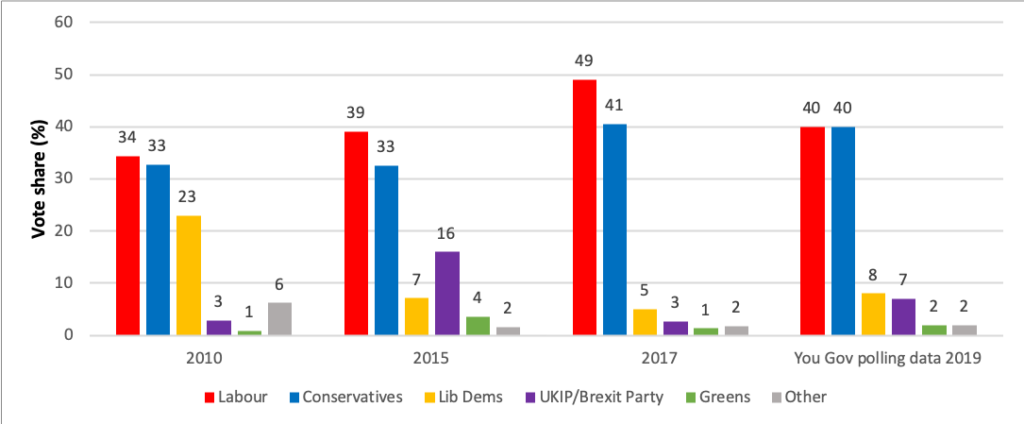
Polling sources: Benjamin Lauderdale and Jack Blumenau for YouGov, 10 December, national MRP poll.
Labour seats the Conservatives and Brexit Party are targeting
There is a total of eight seats in Yorkshire and the Humber currently held by Labour that YouGov’s seat-by-seat forecast on 10 December has identified as likely to be won by the Conservatives at this election. These largely, though not exclusively, are already marginal, with Labour majorities of under 10%, and they all voted majority to Leave in 2016, though by varying margins. These are, in the order of probability of switching, from highly likely to more uncertain: Penistone and Stocksbridge (2.7% Labour majority; 61% Leave); Don Valley (11.2% majority; 68.5% Leave); Wakefield (4.7% Lab majority; 63% Leave); Colne Valley (ultra marginal both ways: a Labour majority of just 0.5% and a 50/50 Leave/Remain vote); Rother Valley (7.8% Lab majority; 67% Leave); Scunthorpe (8.2% majority; 69% Leave); Keighley (ultra marginal with just a 0.5% majority and a Leave vote of 53%) and Great Grimsby (7% majority, 71% Leave). In YouGov’s poll and seat forecast at the end of November, one further seat, Dewsbury (5.9% Lab majority and 53.3% Leave vote), was also forecast to be a Conservative gain, but a tightening of the polls has changed the forecast here in the final week of the campaign, and Labour are expected to retain it.
A constituency poll for Great Grimsby by Survation in late November put the Conservatives on 44% to Labour’s 31%, so moving it securely into the Conservative column. However, YouGov’s more recent forecasts are tighter (42% Conservative to Labour’s 41%), making it too close to call. It also indicates the Brexit Party will perform well, on 11%. UKIP won 25% of the vote in Great Grimsby in the 2015 general election. Farage’s core claim in 2019 has been that the Brexit Party are better placed to attract former Labour voters who support Brexit than the Conservatives in constituencies like this, and they are standing candidates in all these nine seats discussed above, but are polling in the low to mid-teens, typically.
In a further cluster of seats currently held by Labour, the forecast vote share for the Brexit Party is higher, and is such that Leave-supporting votes in opposition to Labour are split between them and the Conservatives, so ensuring Labour retains the seats. In Barnsley Central, where Sheffield City Region mayor Dan Jarvis is the incumbent, they are forecast to achieve their highest vote share in the country, on 30% of the vote to Labour’s 45%, with the Conservatives falling back to 16%. Similarly in Barnsley East and Doncaster North (Ed Miliband’s seat) and Kingston upon Hull East the Brexit Party are forecast to poll above 20%, enough to draw level with the Conservatives and split the vote three ways, but with Labour still comfortably ahead.
Labour targets
With tiny Conservative majorities of just 0.6% and 1% respectively, Pudsey and Calder Valley are Labour targets in a region they have few. They held both seats between 1997 and 2010, but on current polling look unlikely to regain either.
York Outer has been held by the Conservatives since the constituency was formed in 2010, and they currently have a 14% majority. However, the constituency voted 55% Remain in the referendum, so could be seen as a target by Remain parties. On current polling, though, the Conservative incumbent Julian Sturdy is set to hold it, helped by the fact that opposition votes are forecast to be split between Labour and the Lib Dems. YouGov’s forecast puts the Conservatives on 47% to Labour’s 35% and the Lib Dems’ 17%, and as such all Remain tactical voting sites recommend voting for Labour candidate Anna Perrett.
Liberal Democrat targets
In 2017, former leader of the Liberal Democrats Nick Clegg, who held on to his seat of Sheffield Hallam in the party’s rout in the 2015 election, was dramatically kicked out. He was ousted by Labour, thanks to their strong performance in urban, pro-Remain seats with significant student populations. This win was somewhat of a poisoned chalice for the Labour Party, after a series of stories emerged about their new MP for the constituency, Jared O’Mara, including offensive comments he had made online about women and LGBT people. He had the whip suspended within a few months of entering Parliament, and subsequently sat as an independent. In 2019, other allegations surfaced, including a charge for fraud, and he said he would stand down from Parliament in September 2019. Against this background, the new Labour candidate looks unlikely to retain the seat, with the Lib Dems’ forecast to retake it, though it remains close.
Figure 3: Yorkshire and the Humber’s most marginal seats (by % vote) from the 2017 election
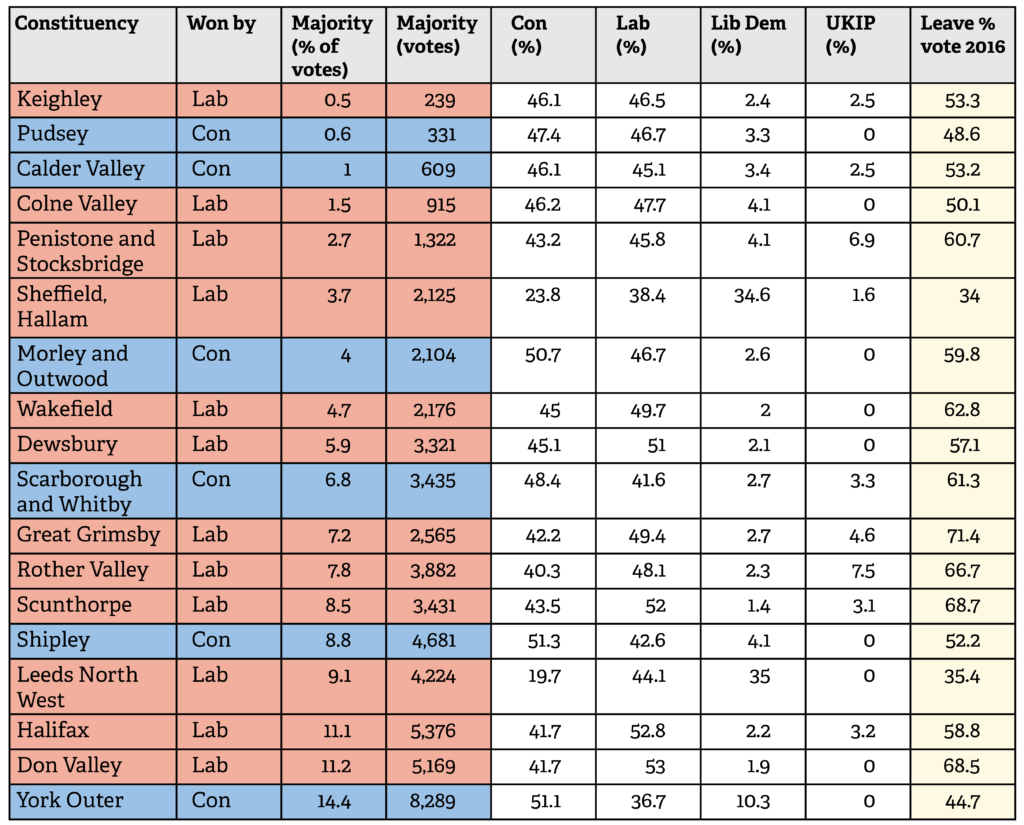
Note: The Leave % for each the 2016 Brexit referendum by constituency (and mentioned throughout this article), are Chris Hanretty’s estimates. You can also find these for each constituency (including those we don’t discuss), along with general election results at DemocraticDashboard.com.





 Democratic Audit's core funding is provided by the Joseph Rowntree Charitable Trust. Additional funding is provided by the London School of Economics.
Democratic Audit's core funding is provided by the Joseph Rowntree Charitable Trust. Additional funding is provided by the London School of Economics.